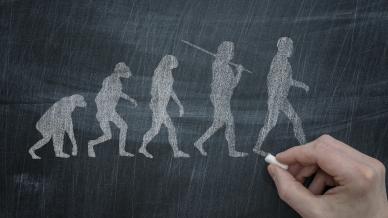Most people have heard of Neanderthals as a close cousin of the modern human. Less well known is the fact that 12 other species of human have come and gone over the last five million years. This begs the question: why have homo sapiens colonised every corner of the globe, yet the others are now extinct?
Five million years is a relative heartbeat in evolutionary terms, yet we humans have managed to progress extremely quickly compared to other creatures. (For example, crocodiles have barely changed for over 200 million years.) Part of the answer lies in what makes us human: our big brains. Compared to, say, the T-Rex, which had a massive body and tiny brain, our own brain-to-mass ratio is off the charts.
This intelligence has allowed us to accelerate our evolution. By using and then making tools, harnessing fire, wearing clothes and developing complex languages, we’ve gained the skills to survive in different habitats, consume a wider range of foods, pass down knowledge and protect ourselves from predators. The more we’ve moved about, the more we’ve adapted, with the most effective adapters passing their genes on to the next generation. Welcome to Darwinism on fast forward.
As mentioned earlier, Homo sapiens weren’t the only humans on the scene. Species such as Homo habilis (known as the Handyman) used tools such as stones and the sharp edges of broken bones. Homo erectus, possibly the first to stand fully straight, learnt how to make fire and fashion tools. The Neanderthals, with their distinctive heavy brows and incredible strength, were adept hunters, who could pull down vast elephants, rhinos, bison and cave-dwelling lions.
But they’ve all gone, and we’re still here, expanding our population at a faster rate than ever before. Ready for the disappointing bit? We don’t know the exact reason why. But there are some very plausible explanations, so please pick your favourite.
One theory is that Homo sapiens were better fighters with better weapons and so wiped out their rivals. I don’t buy into that. There is clear evidence that we lived side by side with other homo species. Indeed, we interbred with Neanderthals and elements of Neanderthal DNA remain in our own to this day.
Interesting fact: Due to the vast population of humans, there is now more Neanderthal DNA on the planet than there ever was when Neanderthals were extant.
So, the likelihood is that we learned extensive skills and knowledge from our homo cousins – how to make tools and weapons, what’s safe to eat etc – which contributed to our rapid evolution.
Was it superior language skills that allowed Homo sapiens to pass on complex information? If you can explain how to steer clear of sabre-toothed tigers, then that person doesn’t need to work it out through trial and (likely fatal) error.
Perhaps the dominance of Homo sapiens owed more to the weaknesses of other human species, which may have struggled to cope with temperature change or new strains of disease. Neanderthals lived sedentary lives in small family groups, so maybe they were eventually outnumbered and squeezed into extinction.
Neanderthals rarely reached their 20th birthday, which meant that any innovations needed to be passed down from one teenager to the next. Imagine if all our knowledge was reliant on teenagers today! Homo sapiens lived longer, which helped avoid the need to keep learning important stuff for the first time.
Either way, about 50,000 years ago, Homo sapiens appears to have crossed a threshold in cognitive ability. It could have been a series of fortuitous chromosomal mutations that turbocharged our evolution – we can’t know for sure – but we soon became an unstoppable force, with the smarts to adapt to almost all of the different conditions on Earth. We were the ultimate generalist specialist: pervasive worldwide, but locally diverse.
Today’s Homo sapiens has developed in many areas, but regressed in others too. We continue to cause the extinction of ancient species every year. Perhaps our voracious behaviour will accelerate the elimination of our own species, despite the warning signs. But let’s not overstate our importance. In the grand scheme of evolution, the rise and fall of Homo sapiens is but a tick on the clock of time.
Inspired?
For more food for thought, why not become a member for £15 a year and enjoy our weekly online lectures. See the button below for more details.
















